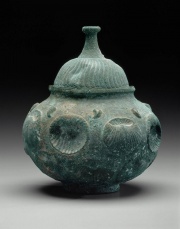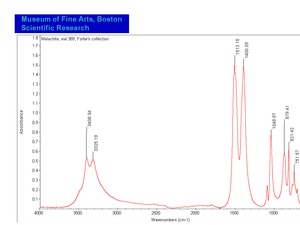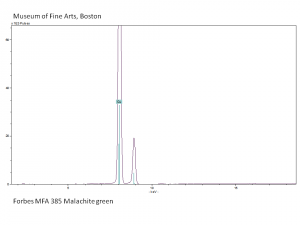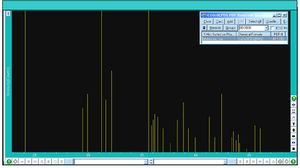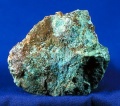Difference between revisions of "Malachite"
m (Text replace - "== Authority (list of all sources checked for information on this subject)==" to "== Sources Checked for Data in Record ==") |
|||
| (28 intermediate revisions by 3 users not shown) | |||
| Line 1: | Line 1: | ||
| − | [[File:1997.185-SC64775.jpg|thumb| | + | [[File:1997.185-SC64775.jpg|thumb|Roman bronze dish<br>MFA #: 1997.185]] |
== Description == | == Description == | ||
| − | + | [[File:malachitedw.jpg|thumb|Malachite]] | |
A green mineral composed of [[basic copper carbonate]]. Malachite occurs naturally with the blue copper carbonate mineral called [[azurite]] with malachite being the more abundant of the two. Major deposits of the copper ores have been found in Siberia (Nizhne-Tagilsk), France (Chessy), Nambia (Tsumeb), Congo, Australia (New South Wales), and the U.S. (Bisbee, Arizona). Both malachite and azurite have been used as gemstones and paint pigments since before 3000 BCE. Malachite is prepared as pigment by careful selection, grinding, washing, and levigation. Coarsely ground malachite gives a dark green color while finely ground particles give a lighter more transparent tone. Malachite is a lightfast but is sensitive to acids and sulfur fumes. Basic copper carbonate can also be made artificially by coloring chalk with [[copper sulfate]]. The synthetic pigment, called [[green verditer]], tends to have regularly sized particles with rounded edges with a paler color than malachite. Natural malachite was occasionally used in tempera based paintings before the 16th century and later, green verditer was used for both distemper and oil based interior house paints in the 19th century. Malachite is also found as a corrosion product on metallic [[copper]]. | A green mineral composed of [[basic copper carbonate]]. Malachite occurs naturally with the blue copper carbonate mineral called [[azurite]] with malachite being the more abundant of the two. Major deposits of the copper ores have been found in Siberia (Nizhne-Tagilsk), France (Chessy), Nambia (Tsumeb), Congo, Australia (New South Wales), and the U.S. (Bisbee, Arizona). Both malachite and azurite have been used as gemstones and paint pigments since before 3000 BCE. Malachite is prepared as pigment by careful selection, grinding, washing, and levigation. Coarsely ground malachite gives a dark green color while finely ground particles give a lighter more transparent tone. Malachite is a lightfast but is sensitive to acids and sulfur fumes. Basic copper carbonate can also be made artificially by coloring chalk with [[copper sulfate]]. The synthetic pigment, called [[green verditer]], tends to have regularly sized particles with rounded edges with a paler color than malachite. Natural malachite was occasionally used in tempera based paintings before the 16th century and later, green verditer was used for both distemper and oil based interior house paints in the 19th century. Malachite is also found as a corrosion product on metallic [[copper]]. | ||
| − | [[File: | + | [[File:Malachite_Zairekes.jpg|thumb|Malachite]] |
| − | + | [[[SliderGallery rightalign|Malachite, FC 389, 532nm.TIF~Raman (MFA)|Malachite (bottle 389).TIF~FTIR (MFA)|Slide16 FC385.PNG~XRF (MFA)|mMalachite xrd.jpg~XRD (MFA)]]] | |
== Synonyms and Related Terms == | == Synonyms and Related Terms == | ||
basic copper carbonate; Pigment Green 39; CI 77492; Berggrün (Deut.); Malachit (Deut.); verdetto della Magna (It.); malachito (It.) malaquita (Esp.); malaquite (Port.); malachite (Fr., It.); malachitis (Gr.); malachiet (Ned.); rokusho (Jap.); iwarokusho (Jap.); byaku roku (Jap.); shih lü; (Chin.); spang (Tibetan); verde azzurro; basic cupric carbonate; green hydrous copper carbonate; green bice; Bremen green; green verditer; Hungarian green; mountain green; mineral green; copper green; iris green; Olympian green | basic copper carbonate; Pigment Green 39; CI 77492; Berggrün (Deut.); Malachit (Deut.); verdetto della Magna (It.); malachito (It.) malaquita (Esp.); malaquite (Port.); malachite (Fr., It.); malachitis (Gr.); malachiet (Ned.); rokusho (Jap.); iwarokusho (Jap.); byaku roku (Jap.); shih lü; (Chin.); spang (Tibetan); verde azzurro; basic cupric carbonate; green hydrous copper carbonate; green bice; Bremen green; green verditer; Hungarian green; mountain green; mineral green; copper green; iris green; Olympian green | ||
| − | + | == Risks == | |
| − | == | + | * Skin contact and inhalation may cause irritation or allergic reactions. |
| + | * Chronic exposure may cause anemia. | ||
| + | * Turns black with warm alkalis, hydrogen sulfide or sulfur fumes. | ||
| + | |||
| + | == Physical and Chemical Properties == | ||
Insoluble in water and ethanol. Decomposes in acids with the evolution of carbon dioxide bubbles. Decomposes with warm alkalis. Stable in light. | Insoluble in water and ethanol. Decomposes in acids with the evolution of carbon dioxide bubbles. Decomposes with warm alkalis. Stable in light. | ||
| − | Perfect cleavage in one direction. Streak = green. It is a brittle mineral that fractures conchoidally | + | Perfect cleavage in one direction. Streak = green. It is a brittle mineral that fractures conchoidally. Pigment particles are coarse and irregular. |
| + | |||
| + | Under the polarizing light microscope, malachite is coarse (broad particle size distribution). It has perfect cleavage and the crystalline structure is immediately apparent. Shapes can be euhedral with tabular forms, and are sometimes even prismatic. Banding often apparent in some particles. Smaller particles can appear as shards, (acicular) needle-shapes, or columnar-shapes. Larger particles are often observed often to be fibrous agglomerates or botryoidal masses (grape-like clusters) that do not go to complete extinction in XPL. Larger particles are pale green to blue-green with smaller particles almost colorless. Relief is moderate (and variable upon stage rotation). RI > 1.662 in β and gamma directions but RI = 1.655 in alpha direction. | ||
| + | |||
| + | Malachite is strongly birefringent (0.254) with higher order jewel tones observed (although thinner, smaller particles may exhibit high first-order tones). Some anomalous blues can be seen. Extinction is straight (although some have reported inclined). It has no fluorescence. | ||
{| class="wikitable" | {| class="wikitable" | ||
| Line 30: | Line 38: | ||
|- | |- | ||
! scope="row"| Density | ! scope="row"| Density | ||
| − | | 3.9-4.0 | + | | 3.9-4.0 g/ml |
|- | |- | ||
! scope="row"| Refractive Index | ! scope="row"| Refractive Index | ||
| 1.655; 1.909; 1.875 | | 1.655; 1.909; 1.875 | ||
|} | |} | ||
| − | |||
| − | |||
| − | |||
| − | |||
| − | |||
| − | |||
| − | |||
| − | |||
| − | |||
| − | |||
== Comparisons == | == Comparisons == | ||
| − | [[media: | + | [[media:download_file_436.pdf|Properties of Common Gemstones]] |
| − | |||
| − | |||
== Additional Images == | == Additional Images == | ||
<gallery> | <gallery> | ||
| − | |||
| − | |||
| − | |||
| − | |||
| − | |||
File:Malachiteemr1.jpg|Malachite | File:Malachiteemr1.jpg|Malachite | ||
| − | File: | + | File:malachite C100x.jpg|malachite at 100x (left: visible light; right:UV light) |
| + | File:30_Malachite_200X.jpg|Malachite PPL 200x | ||
| + | File:30_Malachite_200X_pol.jpg|Malachite XPL 200x | ||
| + | File:lo res Malachite PPL 400x.JPG|Malachite PPL 400x | ||
| + | File:Malachite XPL 400x.JPG|Malachite XPL 400x | ||
</gallery> | </gallery> | ||
| − | + | == Resources and Citations == | |
| − | == | + | * Ruth Siddall, 'Mineral Pigments in Archaeology: Their Analysis and the Range of Available Materials' ''Minerals'' Vol 8, p. 201 (2018). [https://www.academia.edu/36588315/Mineral_Pigments_in_Archaeology_Their_Analysis_and_the_Range_of_Available_Materials?email_work_card=view-paper Link] |
| − | + | * R. Gettens, and E. West FitzHugh, "Malachite and Green Verditer", ''Artists Pigments'', Vol. 2., A. Roy ed., Oxford University Press, Oxford, 1993. | |
| + | * Gem Identification Lab Manual, Gemological Institute of America, 2016. | ||
| + | * Mineralogy Database: [http://www.webmineral.com/data/Malachite.shtml Malachite] | ||
* Nicholas Eastaugh, Valentine Walsh, Tracey Chaplin, Ruth Siddall, ''Pigment Compendium'', Elsevier Butterworth-Heinemann, Oxford, 2004 | * Nicholas Eastaugh, Valentine Walsh, Tracey Chaplin, Ruth Siddall, ''Pigment Compendium'', Elsevier Butterworth-Heinemann, Oxford, 2004 | ||
| − | + | * ''Encyclopedia Britannica'', http://www.britannica.com Comment: Retrieved June 5, 2003. | |
| − | |||
| − | |||
| − | * ''Encyclopedia Britannica'', http://www.britannica.com Comment: Retrieved June 5, 2003 | ||
| − | |||
* ''The Dictionary of Art'', Grove's Dictionaries Inc., New York, 1996 Comment: 'Pigments' | * ''The Dictionary of Art'', Grove's Dictionaries Inc., New York, 1996 Comment: 'Pigments' | ||
| − | + | * Wikipedia: [https://en.wikipedia.org/wiki/Malachite Malachite] (Accessed Sept. 10, 2005 and Dec 2022) | |
| − | * Wikipedia | ||
| − | |||
* R. J. Gettens, G.L. Stout, ''Painting Materials, A Short Encyclopaedia'', Dover Publications, New York, 1966 Comment: density=4.0, ref index=1.655; 1.909; 1.875 | * R. J. Gettens, G.L. Stout, ''Painting Materials, A Short Encyclopaedia'', Dover Publications, New York, 1966 Comment: density=4.0, ref index=1.655; 1.909; 1.875 | ||
| − | |||
* G.S.Brady, ''Materials Handbook'', McGraw-Hill Book Co., New York, 1971 | * G.S.Brady, ''Materials Handbook'', McGraw-Hill Book Co., New York, 1971 | ||
| − | |||
* Ralph Mayer, ''A Dictionary of Art Terms and Techniques'', Harper and Row Publishers, New York, 1969 (also 1945 printing) | * Ralph Mayer, ''A Dictionary of Art Terms and Techniques'', Harper and Row Publishers, New York, 1969 (also 1945 printing) | ||
| − | |||
* C.V.Horie, ''Materials for Conservation'', Butterworth-Heineman, London, 1997 | * C.V.Horie, ''Materials for Conservation'', Butterworth-Heineman, London, 1997 | ||
| − | |||
* R.D. Harley, ''Artists' Pigments c. 1600-1835'', Butterworth Scientific, London, 1982 | * R.D. Harley, ''Artists' Pigments c. 1600-1835'', Butterworth Scientific, London, 1982 | ||
| − | |||
* Jack Odgen, ''Jewellery of the Ancient World'', Rizzoli International Publications Inc., New York City, 1982 | * Jack Odgen, ''Jewellery of the Ancient World'', Rizzoli International Publications Inc., New York City, 1982 | ||
| − | |||
* A.Lucas, J.R.Harris, ''Ancient Egyptian Materials and Industries'', Edward Arnold Publishers Ltd., London, 4th edition, 1962 | * A.Lucas, J.R.Harris, ''Ancient Egyptian Materials and Industries'', Edward Arnold Publishers Ltd., London, 4th edition, 1962 | ||
| − | |||
* Thomas B. Brill, ''Light Its Interaction with Art and Antiquities'', Plenum Press, New York City, 1980 | * Thomas B. Brill, ''Light Its Interaction with Art and Antiquities'', Plenum Press, New York City, 1980 | ||
| − | |||
* ''Van Nostrand's Scientific Encyclopedia'', Douglas M. Considine (ed.), Van Nostrand Reinhold, New York, 1976 | * ''Van Nostrand's Scientific Encyclopedia'', Douglas M. Considine (ed.), Van Nostrand Reinhold, New York, 1976 | ||
| − | |||
* ''The American Heritage Dictionary'' or ''Encarta'', via Microsoft Bookshelf 98, Microsoft Corp., 1998 | * ''The American Heritage Dictionary'' or ''Encarta'', via Microsoft Bookshelf 98, Microsoft Corp., 1998 | ||
| − | + | * Art and Architecture Thesaurus Online, https://www.getty.edu/research/tools/vocabulary/aat/, J. Paul Getty Trust, Los Angeles, 2000 | |
| − | * Art and Architecture Thesaurus Online, | + | * Pigments Through the Ages - http://webexhibits.org/pigments/indiv/overview/malachite.html |
| − | |||
| − | * | ||
| − | |||
* ''CRC Handbook of Chemistry and Physics'', Robert Weast (ed.), CRC Press, Boca Raton, Florida, v. 61, 1980 Comment: density=3.7-4.1 | * ''CRC Handbook of Chemistry and Physics'', Robert Weast (ed.), CRC Press, Boca Raton, Florida, v. 61, 1980 Comment: density=3.7-4.1 | ||
Latest revision as of 14:17, 28 February 2024
Description
A green mineral composed of Basic copper carbonate. Malachite occurs naturally with the blue copper carbonate mineral called Azurite with malachite being the more abundant of the two. Major deposits of the copper ores have been found in Siberia (Nizhne-Tagilsk), France (Chessy), Nambia (Tsumeb), Congo, Australia (New South Wales), and the U.S. (Bisbee, Arizona). Both malachite and azurite have been used as gemstones and paint pigments since before 3000 BCE. Malachite is prepared as pigment by careful selection, grinding, washing, and levigation. Coarsely ground malachite gives a dark green color while finely ground particles give a lighter more transparent tone. Malachite is a lightfast but is sensitive to acids and sulfur fumes. Basic copper carbonate can also be made artificially by coloring chalk with Copper sulfate. The synthetic pigment, called Green verditer, tends to have regularly sized particles with rounded edges with a paler color than malachite. Natural malachite was occasionally used in tempera based paintings before the 16th century and later, green verditer was used for both distemper and oil based interior house paints in the 19th century. Malachite is also found as a corrosion product on metallic Copper.
Synonyms and Related Terms
basic copper carbonate; Pigment Green 39; CI 77492; Berggrün (Deut.); Malachit (Deut.); verdetto della Magna (It.); malachito (It.) malaquita (Esp.); malaquite (Port.); malachite (Fr., It.); malachitis (Gr.); malachiet (Ned.); rokusho (Jap.); iwarokusho (Jap.); byaku roku (Jap.); shih lü; (Chin.); spang (Tibetan); verde azzurro; basic cupric carbonate; green hydrous copper carbonate; green bice; Bremen green; green verditer; Hungarian green; mountain green; mineral green; copper green; iris green; Olympian green
Risks
- Skin contact and inhalation may cause irritation or allergic reactions.
- Chronic exposure may cause anemia.
- Turns black with warm alkalis, hydrogen sulfide or sulfur fumes.
Physical and Chemical Properties
Insoluble in water and ethanol. Decomposes in acids with the evolution of carbon dioxide bubbles. Decomposes with warm alkalis. Stable in light.
Perfect cleavage in one direction. Streak = green. It is a brittle mineral that fractures conchoidally. Pigment particles are coarse and irregular.
Under the polarizing light microscope, malachite is coarse (broad particle size distribution). It has perfect cleavage and the crystalline structure is immediately apparent. Shapes can be euhedral with tabular forms, and are sometimes even prismatic. Banding often apparent in some particles. Smaller particles can appear as shards, (acicular) needle-shapes, or columnar-shapes. Larger particles are often observed often to be fibrous agglomerates or botryoidal masses (grape-like clusters) that do not go to complete extinction in XPL. Larger particles are pale green to blue-green with smaller particles almost colorless. Relief is moderate (and variable upon stage rotation). RI > 1.662 in β and gamma directions but RI = 1.655 in alpha direction.
Malachite is strongly birefringent (0.254) with higher order jewel tones observed (although thinner, smaller particles may exhibit high first-order tones). Some anomalous blues can be seen. Extinction is straight (although some have reported inclined). It has no fluorescence.
| Composition | CuCO3-Cu(OH)2 |
|---|---|
| CAS | 12069-69-1 |
| Mohs Hardness | 3.5 - 4.0 |
| Density | 3.9-4.0 g/ml |
| Refractive Index | 1.655; 1.909; 1.875 |
Comparisons
Properties of Common Gemstones
Additional Images
Resources and Citations
- Ruth Siddall, 'Mineral Pigments in Archaeology: Their Analysis and the Range of Available Materials' Minerals Vol 8, p. 201 (2018). Link
- R. Gettens, and E. West FitzHugh, "Malachite and Green Verditer", Artists Pigments, Vol. 2., A. Roy ed., Oxford University Press, Oxford, 1993.
- Gem Identification Lab Manual, Gemological Institute of America, 2016.
- Mineralogy Database: Malachite
- Nicholas Eastaugh, Valentine Walsh, Tracey Chaplin, Ruth Siddall, Pigment Compendium, Elsevier Butterworth-Heinemann, Oxford, 2004
- Encyclopedia Britannica, http://www.britannica.com Comment: Retrieved June 5, 2003.
- The Dictionary of Art, Grove's Dictionaries Inc., New York, 1996 Comment: 'Pigments'
- Wikipedia: Malachite (Accessed Sept. 10, 2005 and Dec 2022)
- R. J. Gettens, G.L. Stout, Painting Materials, A Short Encyclopaedia, Dover Publications, New York, 1966 Comment: density=4.0, ref index=1.655; 1.909; 1.875
- G.S.Brady, Materials Handbook, McGraw-Hill Book Co., New York, 1971
- Ralph Mayer, A Dictionary of Art Terms and Techniques, Harper and Row Publishers, New York, 1969 (also 1945 printing)
- C.V.Horie, Materials for Conservation, Butterworth-Heineman, London, 1997
- R.D. Harley, Artists' Pigments c. 1600-1835, Butterworth Scientific, London, 1982
- Jack Odgen, Jewellery of the Ancient World, Rizzoli International Publications Inc., New York City, 1982
- A.Lucas, J.R.Harris, Ancient Egyptian Materials and Industries, Edward Arnold Publishers Ltd., London, 4th edition, 1962
- Thomas B. Brill, Light Its Interaction with Art and Antiquities, Plenum Press, New York City, 1980
- Van Nostrand's Scientific Encyclopedia, Douglas M. Considine (ed.), Van Nostrand Reinhold, New York, 1976
- The American Heritage Dictionary or Encarta, via Microsoft Bookshelf 98, Microsoft Corp., 1998
- Art and Architecture Thesaurus Online, https://www.getty.edu/research/tools/vocabulary/aat/, J. Paul Getty Trust, Los Angeles, 2000
- Pigments Through the Ages - http://webexhibits.org/pigments/indiv/overview/malachite.html
- CRC Handbook of Chemistry and Physics, Robert Weast (ed.), CRC Press, Boca Raton, Florida, v. 61, 1980 Comment: density=3.7-4.1
